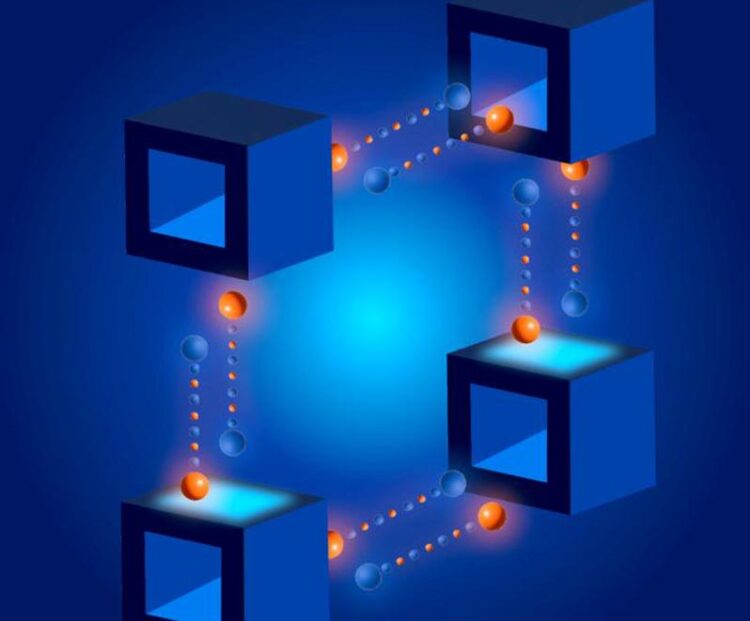Criterion for nonlocal quantum behavior in networks

Entangled quantum objects can be used to network separated systems. The researchers demonstrate what is needed for nonlocal correlations, a requirement for a useful quantum network.
Credit: The Grainger College of Engineering at the University of Illinois Urbana-Champaign/Wesley Moore
A new theoretical study provides a framework for understanding nonlocality, a feature that quantum networks must possess to perform operations inaccessible to standard communications technology. By clarifying the concept, researchers determined the conditions necessary to create systems with strong, quantum correlations.
The study, published in Physical Review Letters, adapts techniques from quantum computing theory to create a new classification scheme for quantum nonlocality. This not only allowed the researchers to unify prior studies of the concept into a common framework, but it facilitated a proof that networked quantum systems can only display nonlocality if they possess a particular set of quantum features.
“On the surface, quantum computing and nonlocality in quantum networks are different things, but our study shows that, in certain ways, they are two sides of the same coin,” said Eric Chitambar, a professor of electrical and computer engineering at the University of Illinois Urbana-Champaign and the project lead. “In particular, they require the same fundamental set of quantum operations to deliver effects that cannot be replicated with classical technology.”
Nonlocality is a consequence of entanglement, in which quantum objects experience strong connections even when separated over vast physical distances. When entangled objects are used to perform quantum operations, the results display statistical correlations that cannot be explained by non-quantum means. Such correlations are said to be nonlocal. A quantum network must possess a degree of nonlocality to ensure that it can perform truly quantum functions, but the phenomenon is still poorly understood.
To facilitate study of nonlocality, Chitambar and physics graduate student Amanda Gatto Lamas applied the formalism of quantum resource theory. By treating nonlocality as a “resource” to manage, the researchers’ framework allowed them to view past studies of nonlocality as separate instances of the same concept, just with different restrictions on the resource’s availability. This facilitated the proof of their main result, that nonlocality can only be achieved with a limited set of quantum operations.
“Our result is the quantum network analogue to an important quantum computing result called the Gottesman-Knill theorem,” Gatto Lamas explained. “While Gottesman-Knill clearly defines what a quantum computer must do to surpass a classical one, we show that a quantum network must be constructed with a particular set of operations to do things that a standard communications network cannot.”
Chitambar believes that the framework will not only be useful for developing criteria to assess a quantum network’s quality based on the degree of nonlocality it possesses, but that it can be used to expand the concept of nonlocality.
“Right now, there is a relatively good understanding of the type of nonlocality that can emerge between two parties,” he said. “However, one can imagine for a quantum network consisting of many connected parties that there might be some kind of global property that you can’t reduce to individual pairs on the network. Such a property might depend intimately on the network’s overall structure.”
The researchers’ article, “Multipartite Nonlocality in Clifford Networks,” is available online.
DOI: 10.1103/PhysRevLett.130.240802
Chitambar is also a member of the Illinois Quantum Information Science and Technology Center. This study is the culmination of work started when Gatto Lamas was a participant in the Research Experience for Undergraduates program hosted by the U. of I. physics department.
Support was provided by the Q-NEXT program led by the U.S. Department of Energy’s Argonne National Laboratory.
Journal: Physical Review Letters
DOI: 10.1103/PhysRevLett.130.240802
Article Title: Multipartite Nonlocality in Clifford Networks
Article Publication Date: 15-Jun-2023
Media Contact
Cassandra Smith
University of Illinois Grainger College of Engineering
casmth11@illinois.edu
All latest news from the category: Information Technology
Here you can find a summary of innovations in the fields of information and data processing and up-to-date developments on IT equipment and hardware.
This area covers topics such as IT services, IT architectures, IT management and telecommunications.
Newest articles

NASA: Mystery of life’s handedness deepens
The mystery of why life uses molecules with specific orientations has deepened with a NASA-funded discovery that RNA — a key molecule thought to have potentially held the instructions for…

What are the effects of historic lithium mining on water quality?
Study reveals low levels of common contaminants but high levels of other elements in waters associated with an abandoned lithium mine. Lithium ore and mining waste from a historic lithium…

Quantum-inspired design boosts efficiency of heat-to-electricity conversion
Rice engineers take unconventional route to improving thermophotovoltaic systems. Researchers at Rice University have found a new way to improve a key element of thermophotovoltaic (TPV) systems, which convert heat…



